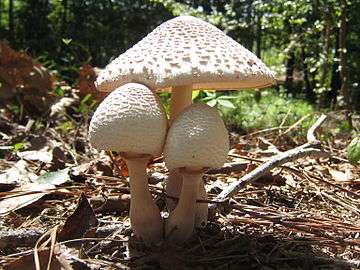Leucoagaricus
Leucoagaricus is a genus of fungi in the family Agaricaceae. Several fungus-growing ants cultivate multiple species for food.[2] The genus contains approximately 90 species.[3]
| Leucoagaricus | |
|---|---|
 | |
| Leucoagaricus nympharum | |
| Scientific classification | |
| Kingdom: | Fungi |
| Division: | Basidiomycota |
| Class: | Agaricomycetes |
| Order: | Agaricales |
| Family: | Agaricaceae |
| Genus: | Leucoagaricus Locq. ex Singer (1948) |
| Type species | |
| Leucoagaricus macrorhizus Locq. ex Singer (1948) | |
| Species | |
|
Around 90, see List of Leucoagaricus species | |
| Synonyms[1] | |
Taxonomy
This group of mushrooms was first defined as a subgenus of Leucocoprinus by Marcel Locquin in 1945, and it was then elevated to the status of genus by Rolf Singer in the journal Sydowia in 1948. The group was characterized as belonging to family Agaricaceae with white, dirty cream or pink spores which are generally small (up to 10 µm) but much bigger in one species, with a germ pore, with a pseudo-amyloid multilayered membrane, simple or ornamented, which is metachromatic in cresyl blue. The hyphae in the sporocarp are without clamp connections. There is always a ring which is initially fixed (but later may be movable).[4]
The type species is Leucoagaricus barssii (Zeller) Vellinga, which was formerly called L. macrorhizus.
Species
Select species include:
- Leucoagaricus americanus
- Leucoagaricus barssii
- Leucoagaricus gongylophorus
- Leucoagaricus leucothites
- Leucoagaricus meleagris
- Leucoagaricus moseri
- Leucoagaricus rubrotinctus
- Leucoagaricus rubrotinctus

- Leucoagaricus barssii
_Singer_117920.jpg) Leucoagaricus meleagris
Leucoagaricus meleagris_Singer_166243.jpg)
References
- "Synonymy: Leucoagaricus Locq. ex Singer". Species Fungorum. CAB International. Retrieved 2014-01-13.
- Hölldobler, Bert; Wilson, Edward O. (2009). The Superorganism: The Beauty, Elegance, and Strangeness of Insect Societies. W. W. Norton & Company. ISBN 9780393067040.
- Kirk PM, Cannon PF, Minter DW, Stalpers JA (2008). Dictionary of the Fungi (10th ed.). Wallingford, UK: CAB International. p. 374. ISBN 0-85199-826-7.
- Singer R (1948). "Diagnoses fungorum novorum Agaricalium". Sydowia (in Latin). 2: 35.
